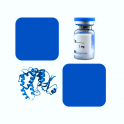
- Remove this product from my favorite's list.
- Add this product to my list of favorites.
Products
Newsletter
 |  |  |  |  |  |

Background
Renin, also known as REN and angiotensinogenase, is a circulating enzyme that participates in the body\'s renin-angiotensin system (RAS), and plays an essential role in the elevation of arterial blood pressure and increased sodium retention by the kidney. Renin activates the renin-angiotensin system by cleaving angiotensinogen, produced by the liver, to yield angiotensin I, which is further converted into angiotensin II by ACE, the angiotensin-converting enzyme primarily within the capillaries of the lungs. Renin is secreted from kidney cells, which are activated via signaling from the macula densa, which responds to the rate of fluid flow through the distal tubule, by decreases in renal perfusion pressure (through stretch receptors in the vascular wall), and by sympathetic nervous stimulation, mainly through beta-1 receptor activation. Renin can bind to ATP6AP2, which results in a fourfold increase in the conversion of angiotensinogen to angiotensin I over that shown by soluble renin. In addition, renin binding results in phosphorylation of serine and tyrosine residues of ATP6AP2. The level of renin mRNA appears to be modulated by the binding of HADHB, HuR and CP1 to a regulatory region in the 3\' UTR. An over-active renin-angiotension system leads to vasoconstriction and retention of sodium and water. These effects lead to hypertension. Therefore, renin inhibitors can be used for the treatment of hypertension.
Source
Recombinant Human RENIN, His Tag (REN-H5221) is expressed from human 293 cells (HEK293). It contains AA Leu 24 - Arg 406 (Accession # P00797-1).
Predicted N-terminus: Leu 24
Molecular Characterization
This protein carries a polyhistidine tag at the C-terminus.
The protein has a calculated MW of 43.1 kDa. The protein migrates as 46-50 kDa under reducing (R) condition (SDS-PAGE) due to glycosylation.
Endotoxin
Less than 1.0 EU per μg by the LAL method.
Purity
>95% as determined by SDS-PAGE.
Formulation
Lyophilized from 0.22 μm filtered solution in PBS, pH7.4. Normally trehalose is added as protectant before lyophilization.
Reconstitution
See Certificate of Analysis for details of reconstitution instruction and specific concentration.
Storage
For long term storage, the product should be stored at lyophilized state at -20°C or lower.
Please avoid repeated freeze-thaw cycles.
This product is stable after storage at:
-20°C to -70°C for 12 months in lyophilized state;
-70°C for 3 months under sterile conditions after reconstitution.
Bioactivity
N/A
(1) "Clinical Decision Support for Hypertension Management in Chronic Kidney Disease: A Randomized Clinical Trial"
Samal, Kilgallon, Lipsitz et al
JAMA Intern Med (2024)
(2) "Angiotensin I and II Stimulate Cell Invasion of SARS-CoV-2: Potential Mechanism via Inhibition of ACE2 Arm of RAS"
Zorad, Skrabanova, Zilkova et al
Physiol Res (2024) 73 (1), 27-35
(3) "Solution is not simple; sodium-glucose cotransporter-2 inhibitor use in Conn syndrome"
Soyaltin
Blood Press Monit (2024)
Showing 1-3 of 70349 papers.
Follow us